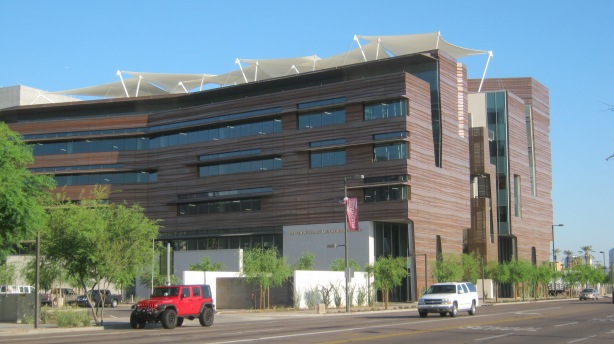CONSTRUCT 2012 – Day 2, Session 1, Fenestration Design
CONSTRUCT 2012, Day 2, session 1.
Thought the classes started at 8:30, but it started 8:00. Good thing it is only 8:10. On my walk in I took a quick walk around tour of the Health Sciences Educational Building on a share UofA and ASU campus.
Topic of the morning, Understanding High Performance Fenestration Technologies
Presenter: Steve Easley
Energy: All solar energy is either transmitted, reflected, or absorbed. Light is either visible light, near infrared energy, ultraviolet light.
Strategies dealing with heat gain:
- Block the light
- Dark tinted glass blocks the light but absorbs the energy that will be radiated in
- Reflect the light
- Reflecting the light is better strategy, but beware of the ‘death ray of the Vegas hotel’
- Reflect the IR
- Low-E coating
Up until the 1980’s, we could tint the glass or use multiple panes. Today we have more options.
Shade helps, a lot.
Anatomy of a Window:
- IG unit
- Edge spacer
- Frame
- Cladding
Performance factors
- Glass: panes, coatings, tings
- Frames: material, thermal breaks
- IG unit: spacers, gas
Comfort: Not just noticing if you are hot or cold. Experience radiant heat comfort of discomfort much more than ambient heat.
Emissivity: It is the opposite relationship of reflectivity. Low-E glass is highly reflective in the IR range.
High solar gain = cold climate
Medium solar gain = medium climate
Low solar gain = hot climate
How to rate windows? NFRC – National Fenestration Rating Council
- U-factor – how conductive is the window in transferring heat (unitary measurement of the entire product)
- Solar Heat Gain Coefficient – how much of the sun’s heat energy is allowed to pass through the window in its entirety
- Visible Transmittance – understand optical products of the glass. Again, this is for the total window.
- Air Leakage –
- Condensation Resistance Factor – 1 to 100, 100 is the best
Glass surface numbers: 1 is the outside and with a double pane window, 4 is the interior face.
A double pane window will help with the U-factor, but not much in terms of keeping out the sun’s energy. Adding a low-e coating and an inert gas will make a huge difference in keeping out the sun’s energy.
Condensation: Product of humidity and thermal conductivity. Condensation can occur on the interior or exterior of the glass.
The quality of the spacers within the IGU is critical. An aluminum spacer that touches both panes of glass will lead to edge condensation. Need to specify silicone as the seal. Recommend thin gauge stainless steel spacer filled with desiccant. The spacer should not touch the glass, separated by the primary seal. Also provide a secondary silicone seal.
Argon and Krypton will provide for a higher R-value, lower U-value for the insulated glazing unit. The sweet spot is ½” air space. Krypton costs 5,000 times more than Argon. The Argon is heavier than air and makes it harder for convection within the glazing unit.
Warm Edge Technology – way to isolate spacer from glass.
2pE366 glass blocks out most of the UV and heat, but allows in visible light. The 2pE366 code means something to window people.
Energy of the sun = short wave length energy. It gets absorbed and is radiated as long length energy.
Heat will always go from warm to cold and the greater the delta the faster the heat moves.
Is there any merit of moving the low-e coating to surface 3 in a cold climate? In terms of thermal energy transfer, it doesn’t matter. The question of surface 2 or 3 is about the solar properties of the window. In a relatively cold climate, there is merit to put the low-e coating on surface 3. However, what about the summer. This would lead to warmer surface temperatures on the glass. There is also the potential of having more thermal stress within the insulated glazing unit.
High solar gain low-e glass blocks 52% of the sun’s heat.
Low solar gain low-e glass blocks 78% of the sun’s heat.
Sun = 230 Btu/hr-ft2
Clear glass = 140 Btu allowed to pass through
Low Solar – Low-e = 54 Btu allowed to pass through
Dark tints absorb heat and block light. Purpose of the today’s discussion, think tripled Low-E coating before tinted glass. This will be the most cost effective approach.
ASHRAE 90.1 heavily favors metal windows. The way it does it costs effective modeling. Will lead you to believe metal windows are better performers than non-metal windows. Tinted glass will not help you in the winter.
Interesting quote of the morning: Code officials will not enforce a code they do not understand.
UV Transmission
- Has no influence on energy performance
- Fades fabrics, furniture and finishes
- Light in the visible spectrum can also causes fading
- Low-e coatings will reduce UV transmission
Selecting windows for structural performance
- Window performance and grade
- Look for AAMA permanent labels
- Windload Conversions
- http://www.nctlinc.com/velocity-chart/
- R = Residential
- 15 PSF = minimum design pressure
- 22.5 PSF = mimimum structural test pressure
- 2.86 PSF = mimimum water resistance test pressure
- This information is published by AAMA
Second quote of the morning: “Never tuck you rain coat into your under-ware.”
Google search “energy videos.com”



